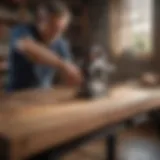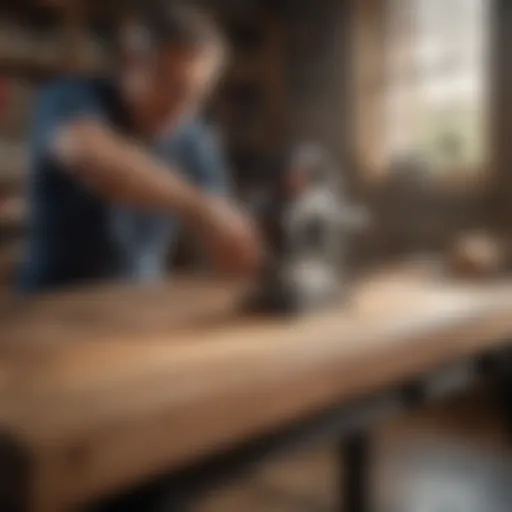Effective and Safe Wallpaper Removal Techniques
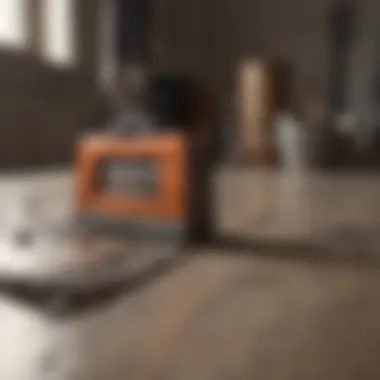

Intro
Removing wallpaper might sound like a simple task, but it can quickly become a thorn in the side for many homeowners. It's not just about stripping away layers of paper; it's about doing it safely and efficiently. The right approach can save not only time and associated costs but also the potential headaches that arise from improper removal.
Overview of Topic
Wallpaper has long been a favored choice for adding character and style to a home. Over the years, its popularity has seen a resurgence, resulting in a plethora of designs and materials. However, the inevitability of change—whether due to wear and tear or simply a desire for a fresh look—means that removing wallpaper is a task many will encounter.
Understanding the fundamentals of wallpaper removal is crucial. Homeowners need to be aware of the different adhesive types used, as each requires a unique approach to removal. Some wallpapers peel off easily, while others cling tightly and may require a bit more elbow grease.
This topic holds importance not just for aesthetic reasons but also from a safety and health perspective. Old wallpapers may contain harmful substances like lead, especially in homes built prior to 1978 when lead-based paints were banned. Hence, being informed about the correct removal techniques is vital to ensure a safe living environment.
Common Challenges and Solutions
Despite the seemingly straightforward nature of wallpaper removal, homeowners often face several hurdles. Here’s a breakdown of typical challenges:
- Adhesive Problems: Many types of wallpaper use strong adhesives that don’t give in easily; this can cause frustration.
- Wall Damage: Improper removal might lead to tearing or damage to the drywall beneath.
- Time-Consuming Process: Removing wallpaper can take longer than anticipated, especially if it's layered or older.
- Health Risks: As previously mentioned, old wallpaper can present health hazards.
Solutions
To navigate these challenges, consider these practical solutions:
- Choose the Right Tools: Invest in quality tools like wallpaper scrapers, steamers, or liquid removers. They can ease the process a great deal.
- Test Adhesive Types: Before going all in, test a small corner to determine the adhesive's stubbornness and plan your strategy.
- Use Protective Gear: This isn’t just about aesthetics—wear gloves and a mask, especially with older wallpapers.
- Take Breaks: If a task stretches longer than expected, taking breaks can prevent dissatisfaction and fatigue.
- Learn From Others: Online resources like Reddit can offer insight from those who have faced the same challenges.
Product Recommendations
When it comes to tackling wallpaper removal, certain products stand out for their efficacy. Here’s a closer look at a few top tools and solutions currently valued in the market:
- Zinsser Smart Strip: This water-based remover is non-toxic and safe, making it suitable for any home.
- WallPops Wallpaper Stripper Tool: Designed ergonomically, this scraper offers ease of use and effective removal without wall damage.
- Steamer by Wagner: This tool provides steam which can help to loosen even the most stubborn wallpaper. It's worth its weight in gold.
Each product has its benefits:
- The Smart Strip is eco-friendly and allows for a cleaner process.
- WallPops Tool reduces the risk of damaging your walls, addressing one of the biggest concerns.
- Steamers provide an all-in-one solution, especially for layered wallpaper.
Step-by-Step Guides
Engaging in wallpaper removal is an art and a science; follow these steps for a thorough and safe process:
- Preparation: Start by clearing the space. Move furniture away and lay down drop cloths to protect your floors.
- Assess and Test: Determine the type of wallpaper and adhesive. Conduct a small test area before diving in.
- Gather Tools: Make sure you have everything on hand—scrapers, steamers, removers, buckets, and protective gear.
- Apply a Remover: Whether you’re using a steamer or liquid solution, soak the wallpaper generously.
- Wait and Peel: Allow time for the solution to penetrate. Start peeling gently, applying more solution if needed.
- Clean Up: Remove all adhesive residues with water and a sponge. Check for any remaining bits of paper and address them promptly.
- Inspect for Damage: After removing the wallpaper, inspect your walls carefully and make any necessary repairs.
You’ll find that taking a methodical approach will yield the best results. Remember, removing wallpaper isn’t just a chore; it’s a chance to refresh your space and create a new environment to enjoy.
As the saying goes: “Good things come to those who wait.” In wallpaper removal, patience is indeed a virtue.
Understanding Wallpaper and Adhesives
When it comes to refreshing your living space, knowing about wallpaper and the adhesives that hold it in place is pivotal. It’s not just about tearing down old layers; understanding the type, texture, and adhesive used can significantly influence the process of removal. Each wallpaper type responds differently to removal techniques, and this knowledge arms you with the right approach, making the task smoother and less daunting. Get ready to arm yourself with valuable insights, making those walls cleaner and ready for a new look.
Types of Wallpaper
Vinyl Wallpaper
Vinyl wallpaper stands out as a popular choice due to its durability and ease of maintenance. This wallpaper often consists of a vinyl layer over a paper or fabric backing, resulting in a water-resistant surface. The key characteristic that makes vinyl wallpaper appealing is its ability to withstand moisture, making it suitable for high-humidity areas like kitchens and bathrooms.
However, its unique feature of being wipeable can also be a double-edged sword; while it’s user-friendly, it can pose challenges when removal time comes. This type often sticks quite well, potentially making removal messy if not done properly, which can be a factor to consider in this guide.
Paper Wallpaper
Paper wallpaper, often seen as the more traditional choice, offers a wide array of designs and patterns that appeal to those seeking a vintage or rustic look. Its main characteristic is absorbency, meaning that it tends to soak up moisture during removal. This makes it simple to work with when you use the right wet techniques.
What sets paper wallpaper apart is its breathability, which can contribute positively to indoor air quality. However, it’s worth noting that it may show wear and tear quicker than vinyl and might not be the best option for areas prone to moisture. Consider planning for its upkeep when choosing this wallpaper type.
Fabric Wallpaper
Fabric wallpaper adds a layer of sophistication and texture to a room, but it’s not without its quirks. The key characteristic of fabric wallpaper is its rich and tactile feel, often appealing to those looking for elegance. The unique feature here is its ability to add warmth to a space, capturing the essence of textiles without the permanent commitment of paint.
However, one must be cautious; while it can conceal imperfections in the wall, fabric wallpaper can be harder to remove. Its adhesive can be strong and messy, particularly if it’s a permanent fixture. Weighing the pros and cons is therefore essential before going down this road.
Common Adhesives Used
Water-Based Adhesives
Water-based adhesives are commonly found in many types of wallpaper. The trendy aspect is their relatively low toxicity and ease of cleanup. These adhesives provide adequate holding power for lighter wallpapers, making them a great recyclable material choice that aligns with eco-friendly values.
This unique feature allows for simpler removal since they dissolve easily in water. However, if your wallpaper is heavier or in a high-humidity area, you may find that these adhesives won’t hold up well over time, leading to premature peeling.
Solvent-Based Adhesives
Solvent-based adhesives are often reserved for heavier and more demanding wallpaper types. The strength of these adhesives lies in their ability to bond well under various environmental conditions, giving them a place in more long-lasting installations.
Nevertheless, as a drawback, these adhesives can be a bit trickier to remove, potentially leaving sticky residue behind that is difficult to clean up. Understanding the challenges of these adhesives can save you a lot of headache when it's time to take your old wallpaper down.
Removable Adhesives
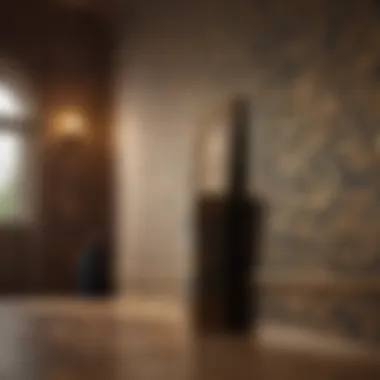

Removable adhesives have gained popularity due to their user-friendliness and versatility. They offer a temporary bond, allowing you to easily change your decor without damaging the walls beneath. The unique aspect of this type of adhesive is how it enables quick transformations without the commitment of traditional wallpaper.
However, while they sound like a dream come true, it’s important to consider their limitations. They might not provide the same longevity as more traditional adhesives and can be prone to lifting if exposed to moisture.
Wallpapers and adhesives bring both the charm and challenge into your home improvement projects. Knowing the intricacies involved means you’ll be better equipped to navigate the wallpaper removal process effectively.
Preparation for Removal
Preparing for wallpaper removal is not just a formality; it’s the backbone of a smooth and efficient process. Investing a little time in preparation saves you from future headaches and ensures that the task at hand goes off without a hitch. It’s about laying the groundwork, quite literally, for a task that can otherwise become chaotic. Selecting the right tools and safeguarding your environment are fundamental steps that form the bedrock of any successful wallpaper removal project. From keeping your floors and furniture protected to ventilating your workspace, every ounce of preparation counts.
Gathering Necessary Tools
When it comes to removing wallpaper, having the right tools in your arsenal can make a world of difference. Think of these tools as your allies, helping you tackle each obstacle with ease.
Scrapers
Scrapers are among the most essential tools for wallpaper removal. Their main function is to lift and peel off the wallpaper without damaging the underlying surface. The key characteristic of a good scraper is its edge, which is often finely sharpened to penetrate the adhesive holding the wallpaper in place. While there are various options available, the plastic scraper tends to be a crowd favorite because it's less likely to gouge your walls compared to metal ones. However, the downside is that you may need a bit more muscle when using a plastic scraper for stubborn wallpaper styles. Still, it offers a safer option and minimizes the risk of damage.
Steamers
Steamers offer a more modern approach to wallpaper removal. They work by applying heat and moisture, which helps to loosen the adhesive on the wallpaper. The main advantage of using a steamer is its efficacy with stubborn wallpaper that clings for dear life. This tool provides a nice, controlled application of heat, making the removal process faster in many cases. On the flip side, steamers can be a bit pricey, and one must be cautious to prevent any steam burns or damage to the walls if not used properly. But their unique capability to dissolve issues quickly makes them a favored option among many do-it-yourselfers.
Soaking Solutions
Soaking solutions, such as mixtures of warm water and a few drops of dish soap or vinegar, can also be deceptively simple yet highly effective options. The beauty of soaking solutions lies in their minimal ingredients, plus they can often be made right from items in your pantry. This method’s key characteristic is its ability to be more environmentally friendly compared to harsher chemical products. The downside, however, is that you need to exercise patience, allowing the solution to soak in for a while to achieve the desired result. While this might not be the fastest option out there, it is often the gentlest on both your walls and the planet.
Safeguarding Your Space
Before jumping in with both feet, it’s crucial to ensure that the area is protected. Safe preparation extends to everything surrounding the area being worked on.
Protecting Floors
Protecting your floors is an often overlooked element of wallpaper removal. Drops of water, adhesive, or even bits of wallpaper can easily mar a beautiful floor. The key here is to utilize drop cloths or old sheets to act as a buffer between your work and the floor surface. While it might seem like a hassle to set this up, it can save you time and effort in cleaning up later on. The downside might be if they slip and slide while you’re moving about. Yet, being proactive with prevention is always more effective than post-removal cleaning.
Covering Furniture
Furniture is a red flag when it comes to DIY jobs. Dust, water, and who knows what else can easily ruin your beloved upholstery or wooden surfaces. Covering furniture thoroughly with plastic sheeting or old towels is a wise move. This step protects against inadvertent splashes and in case you're not the most graceful during the removal process. The unique feature of covering furniture is that it shields against all sorts of mishaps. The only downside is the time it takes to secure everything, but think of it as an investment in peace of mind.
Ventilation Considerations
Ventilation is so often ignored yet plays a pivotal role in any home improvement project, especially with wallpaper removal. A well-aired room helps keep the air fresh when using steamers and soaking solutions, which might cause some lingering smells. It also ensures that odors from any adhesive removers dissipate quickly. Ensure windows are open and, if possible, place fans strategically to flow air properly. The challenge is balancing the cool airflow while working with steam, but it’s certainly worth the effort to avoid headaches later on.
Proper preparation stands tall as the unsung hero of wallpaper removal endeavors! Every small step contributes immensely to a worry-free experience.
Methodologies of Wallpaper Removal
When it comes to removing wallpaper, there’s no one-size-fits-all method; it requires careful thought and planning. Understanding varying methodologies in wallpaper removal is crucial for achieving optimal results. Each technique can influence the ease of the process, and choosing the right one can prevent unnecessary damage to walls while ensuring minimal mess. Moreover, familiarity with various methods empowers DIY enthusiasts, allowing them to adjust their approach based on the wallpaper type and adhesive used.
This section delves into the different methodologies, highlighting wet and dry techniques, as well as combination methods that leverage the strengths of both. Each approach has its own nuances, benefits, and considerations worth noting. With the right knowledge, homeowners can navigate through this project similarly to seasoned professionals, delivering satisfying results.
Wet Removal Techniques
Using Water and Soap
Utilizing water combined with soap is an age-old trick that has withstood the test of time in wallpaper removal. This method is widely recognized for its simplicity and effectiveness in dissolving adhesives. The key characteristic of this technique lies in its gentle nature, minimizing the risk of damage to both the wallpaper and the wall beneath.
The unique advantage of using water and soap is that it is accessible and straightforward, requiring little more than a sponge and a bucket. The gentle scrubbing action allows users to apply just enough pressure to lift the paper without scaring the surface underneath. One downside, however, is that it may not work as effectively on thicker, more stubborn wallpapers.
Vinegar Solutions
Vinegar has emerged as a popular choice in the DIY community, celebrated for its natural properties. This acidic solution works wonders in breaking down the adhesive bonds, making it easier to peel off wallpaper. The standout attribute of vinegar solutions is their eco-friendliness, providing a non-toxic option for households.
Moreover, vinegar solutions can often outshine traditional cleaners in effectiveness against certain adhesives. However, this method requires some patience, as the solution must sit on the wallpaper for a while to work its magic. An important consideration is that the smell can be quite overpowering initially, which might be a concern for those sensitive to strong odors.
Commercial Removing Products
For those seeking a faster and more aggressive solution, commercial removing products are available in abundance. These specialized liquids can penetrate stubborn adhesives more efficiently. The notable feature of these products is their intensive formulation designed specifically for wallpaper removal.
While these solutions promise quick results, it’s essential to choose carefully. Some contain harsh chemicals that may not be suitable for every environment, particularly in households with kids or pets. It's crucial to follow safety instructions and ensure adequate ventilation when using these products.
Dry Removal Techniques
Scoring the Wallpaper
Scoring wallpaper, also known as perforating, involves making small incisions in the surface of the wallpaper. This technique encourages moisture to penetrate through, allowing for easier lifting of the paper. The primary benefit of scoring is its capacity to be combined with other methods, enhancing effectiveness.
This method can be beneficial in tackling older wallpapers that have set firmly over the years, as it allows moisture to bond more effectively with the adhesive. A downside, however, is the potential for damage; if not done carefully, it may lead to scratches or gouges in the underlying wall.
Using Heat Guns
Heat guns serve as another effective tool in wallpaper removal. By melting and softening the adhesive, they allow for easier peeling. The defining feature of heat guns is their ability to provide quick results, making them a favored option among some DIYers.
Despite their efficiency, caution should be exercised. The heat can potentially scorch walls or start a fire if used carelessly. Furthermore, they can be noisy and must be used with protective equipment to avoid burns, making this method less convenient for prolonged use.
Employing Wallpaper Strippers
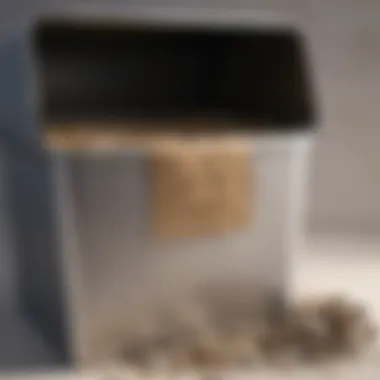

Wallpaper strippers are mechanical devices that peel off wallpaper in one swift motion. This method shines when faced with larger areas or thicker wallpaper types. The unique aspect of this approach is the time savings; it effectively speeds up the removal process substantially compared to other methods.
However, these devices can be quite an investment, and not all are equally effective on every type of wallpaper. It’s worth checking the specifications to ensure compatibility with your current task.
Combination Techniques
Moisture and Scraping
Using moisture alongside scraping tools offers a practical approach to wallpaper removal. The delightful chemistry here helps to break down adhesive while physically dislodging wallpaper. This method combines the strengths of wet removal with mechanical techniques, making it efficient for a broad range of wallpaper types.
The primary advantage of this method is its adaptability; it works well for slight variations in wallpaper thickness. Yet, it demands skill in balancing the applied pressure. Too much scraping can lead to wall damage, so users need to maintain a gentle touch.
Steam and Score
Combining steam with scoring represents a game-changer for difficult wallpapers. This technique utilizes steamers that blast hot vapor onto the wallpaper. The heat softens the adhesive while the scoring method allows for better penetration. The effectiveness here lies in the synergy of techniques, making it a powerful ally in wallpaper battles.
While this method can prove incredibly effective, careful monitoring is critical to avoid steam burns or damaging the underlying wall. It’s an approach that requires patience and precision but promises satisfactory results when executed correctly.
Always remember, the goal is to remove wallpaper without leaving your walls looking worse than before. Choosing the right method, whether wet, dry, or a combination, can make all the difference.
Dealing with Residual Adhesive
When the wallpaper comes down, it can feel like a small victory; however, the fight is not over yet. Residual adhesive, that stubborn sticky stuff left behind, can become a major headache if not addressed properly. Neglecting this layer can lead to an uneven wall, not to mention future wallpaper or paint jobs could easily peel or bubble if the surface isn't taken care of. So, tackling residual adhesive is essential for achieving a pristine finish and ensuring the longevity of any new décor.
In this section, we’ll dive into identifying the types of adhesive you might encounter, as well as the most effective ways to remove the remnants that linger post-removal.
Identifying Adhesive Types
Before embarking on the removal of that adhesive layer, it’s crucial to know what you’re dealing with. Different types of adhesive were used based on the wallpaper application, and understanding these will guide your removal strategy.
Traditional Remnants
Traditional adhesives often consist of wheat paste or similar mixtures used before the advent of modern formulations. This type is characterized by its moisture sensitivity, usually easing up with water. It’s considered a more eco-friendly choice because it's made from natural ingredients.
The advantage here is that removal can often be accomplished without harsh chemicals, making it a popular option among homeowners who prioritize safe practices in their DIY projects.
However, the downside lies in its potential to leave a chunky residue when not removed properly, requiring some additional effort in scraping and rinsing. Keeping the wall clean and ready for the next design is just as important as the initial removal, so stay vigilant.
Modern Adhesive Issues
On the flip side, modern adhesives can be a real pickle. Formulated to be stronger and last longer, these adhesives often contain synthetic components, which make them much trickier to remove. These adhesives can bond like glue, literally, and may require more than just soapy water for their dissolution.
Their main advantage is providing longevity and ensuring wallpapers stay put over time, but that same strength becomes a disadvantage when the time for removal arrives.
It’s also worth noting that some modern adhesives are marketed as removable, a feature that can work, but often not without some fuss. You might find you’ll need specialty solvents that could be slightly harsher, potentially raising concerns over environmental impact.
Effective Removal Methods
Once you've identified the adhesive type, it's time to get down to business. There are a few tried-and-true methods that can address even the most stubborn remnants post wallpaper removal.
Chemical Solutions
Chemical removers designed to tackle adhesives can be wonderfully effective, particularly on modern materials. These products range from straightforward solvent-based formulas to more complex solutions.
The primary benefit is their strength; they dissolve adhesives almost effortlessly. However, caution is key here. Ensure you’re in a well-ventilated area, and take care to wear gloves and a mask to protect against fumes.
The downside? The environmental impact and potential health risks involved with some chemical solutions can leave you feeling a bit uneasy. Always try to read the labels carefully and consider alternatives when possible.
Natural Remedies
If you’re leaning toward eco-friendliness, natural remedies can offer effective solutions too. Common household ingredients like vinegar and baking soda can serve as great allies in your quest to eliminate those pesky adhesive remnants.
The beauty is that these options are usually non-toxic and safe for you and your home environment.
Mixing a solution of equal parts vinegar and warm water sprayed onto the adhesive can soften it significantly.
However, these methods may take a bit longer and require some scrubbing, so patience is key. Natural doesn’t always mean quick and easy, but it is often safer for both you and the planet.
"Choosing removal methods wisely will determine the success of your wallpaper project. Understanding your adhesive types will lead to a smoother process."
In summary, dealing with residual adhesive is not just a mere task; it's a vital part of the wallpaper removal process. Knowing what you've got to deal with, whether it's traditional or modern, will set the stage for effective removal, allowing you to enjoy your freshly cleared walls in no time.
Sustainable Disposal Practices
In the face of ever-growing environmental concerns, addressing how we dispose of wallpaper and its accompanying materials becomes not just relevant, but essential. Sustainable disposal practices not only contribute to reducing waste but also support eco-friendly initiatives and promote a healthier living environment. It’s a step beyond just aesthetic improvement; it’s about ensuring we do our part in preserving our planet.
Recycling Wallpaper Materials
Local Recycling Programs
Local recycling programs are a cornerstone in the realm of environmentally conscious disposal. These initiatives often focus on minimizing landfill waste and maximizing resource recovery. By participating in these programs, homeowners can responsibly discard old wallpaper, turning what was once deemed trash into valuable raw materials for new products. The key characteristic of local recycling programs is their accessibility; typically, these programs are integrated into community services, making them convenient for residents.
A significant advantage of utilizing local recycling programs is their community focus. Often, they are aimed at enhancing local economies by creating jobs related to recycling and materials processing. However, there can be some downsides. Not all wallpaper types are accepted. For instance, vinyl wallpaper might not be recycled in many locations, limiting options for those using specific materials.
Creative Upcycling Ideas
The concept of creative upcycling has gained traction among DIY enthusiasts and environmentally conscious homeowners alike. This approach emphasizes not just waste reduction but also encourages innovation. Homeowners can repurpose old wallpaper into beautiful, functional items like wrapping paper, bookmarks, or even artistic wall décor, thereby giving materials a second life.
One of the most compelling aspects of creative upcycling is its ability to spark imagination and personal expression. It turns the task of disposal into a creative outlet, giving old materials new value. However, this approach may require additional time and effort in comparison to straightforward disposal methods. It's a trade-off between creativity and convenience.
Disposing of Chemical Products
When it comes to wallpaper removal, some products employed may fall under hazardous waste categories. Knowing how to properly dispose of these chemicals is crucial. Hazardous waste guidelines help to steer homeowners in the right direction, ensuring that toxic substances do not unintentionally harm the environment or human health.
Hazardous Waste Guidelines
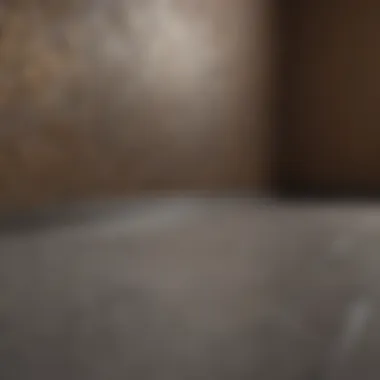

Hazardous waste guidelines are designed to inform residents about how to manage specific materials that contain harmful chemicals. These guidelines can range from simple instructions regarding waste sorting and segregation to detailed protocols for transport. Opting for these guidelines provides both a legal framework and peace of mind, knowing that hazardous materials are being handled correctly.
However, a challenge can arise in understanding what qualifies as hazardous waste. Not all homeowners are familiar with the nuances, which might lead to improper disposal practices if not informed thoroughly.
Safe Disposal Methods
Safe disposal methods complement hazardous waste guidelines by offering practical solutions. They typically encompass strategies like taking chemical products to designated disposal sites or community hazardous waste collection events. By utilizing these methods, homeowners can dispose of unwanted chemicals without creating undue risk to themselves or the environment.
The commendable aspect of safe disposal methods is their emphasis on community resources. Often, cities arrange for collection drives or hazardous waste days, ensuring residents have multiple avenues for responsible disposal. On the downside, such events may not always be frequent, leaving some homeowners stranded with unused chemicals in the interim.
Always remember, your choices in disposal impact not just your immediate surroundings but the global community as well.
Post-Removal Considerations
Once the wallpaper has been stripped away, the next phase is to focus on what comes after removal. This step is often overlooked but is just as crucial as the actual removal process. Post-removal considerations involve ensuring that the walls are not just clean but restored and ready for whatever comes next, be it fresh wallpaper or a coat of paint. Addressing these elements properly can enhance the overall aesthetic quality of your home while also prolonging the life of your chosen finish.
Surface Restoration
Cleaning the Walls
Cleaning the walls after wallpaper removal is an essential step that should not be taken lightly. It’s not just a task of wiping down surfaces; it’s about ensuring all remnants of adhesive and grime are fully eradicated. The key characteristic of this process is its ability to create a pristine canvas for the next design choice. This thorough cleaning process is a beneficial choice because it ensures that whatever decor you apply next adheres properly and lasts longer.
A unique feature of cleaning is that it often involves various techniques, such as using a sponge and warm soapy water or specific cleaners designed for adhesive removal. These methods help in making sure that all sticky remnants are gone. However, it’s important to note that while cleaning solutions are effective, if too harsh, they might damage the wall surface. So, care should be exercised to choose the right cleaner for the job.
Repairing Damage
Once cleaning is done, the focus shifts to repairing any damage that may have happened during the wallpaper removal. This can include scratches, chips, and even larger issues like holes left from tacks or nails. Repairing damage is equally essential, as a smooth wall will allow for better paint or wallpaper application afterward. It's a popular choice for those looking to maintain the integrity of their walls while ensuring an aesthetically pleasing look post-removal.
One unique aspect of this process is the use of patching compounds that come specifically designed for walls. They can easily fill in holes and even out damaged sections. However, it's vital to ensure that any repairs are allowed to dry completely before proceeding. Neglecting this can lead to issues such as bubbling or cracking in the new paint or wallpaper, which may necessitate more work down the line.
Planning for New Wallpaper or Paint
Choosing what to do next with your walls needs careful consideration and planning. This stage allows homeowners to express their creativity and personal style.
Choosing Wallpaper
Choosing new wallpaper requires thoughtful decision-making. The specific aspect of this process involves various factors like pattern, material, and even texture that can significantly impact the room's overall vibe. A key characteristic of wallpaper is its ability to add depth and character to a room. It can transform the most mundane spaces into lively areas filled with personality.
The unique feature of wallpaper is its versatility; you can select from bold prints to subtle textures, ensuring alignment with your personal taste and the room’s purpose. However, it's also crucial to consider the method for application and removal in the future. Some wallpapers are removable, which makes them flexible choices for those who like to change styles frequently but may come at a higher price.
Considering Paint Options
Considering paint options is another pathway for your walls to take. This part of the process is all about colors and finishes that can dramatically change a room’s atmosphere. A key characteristic of paint is its accessibility; not only is it often easier to apply compared to wallpaper, but it also allows for endless color variations. Choosing the right paint can create an inviting or inspiring backdrop to your living spaces.
One unique feature of paint is how it can be easily touched up. Unlike wallpaper, if you have kids or pets, and a wall gets stained or scratched, it’s often a simple fix with a brush and some leftover paint. But unlike wallpaper, there’s a great number of finishes to consider, each offering distinct sheen and durability. Paint might be a more forgiving option for expeditiously updating your home. However, it may require more frequent touch-ups and may not hold up as well against moisture in certain areas unless specified paints are utilized.
Proper post-removal plans for your walls can elevate the entire ambiance of your home while maximizing the life of your decorative choices.
Every step you take during the post-removal period reinforces the foundation for an attractive and durable new look, from maintaining cleanliness to restoring surfaces. This careful calibration can turn labor into art, laying the groundwork for a space that reflects your unique style.
Safety Precautions and Best Practices
When diving into wallpaper removal, it’s crucial to consider safety measures and best practices. This process may seem straightforward at first glance, but there are various risks involved that can sneak up on an unprepared individual. From harmful chemicals to potential physical injuries, being vigilant about safety can save you from a heap of trouble. This section elaborates on the essential precautions to take, providing insights that can lead to a safer and more effective wallpaper removal experience.
Personal Protective Equipment
Gloves
When handling wallpaper and its adhesives, wearing gloves is non-negotiable. These protective garments act as a barrier between your skin and the often nasty substances you might encounter. One key characteristic of gloves is their durability; they come in various materials, such as latex, nitrile, or vinyl. Nitrile gloves, specifically, stand out in this article due to their resistance to punctures and chemicals.
What sets nitrile gloves apart is their snug fit, allowing for dexterity even while protecting your hands. This feature is particularly beneficial if you're using scrapers or other tools where grip matters. However, if you have a latex allergy, relying on nitrile or vinyl is a wise alternative.
Masks
It’s not just your hands that need protection; your lungs deserve some care too. Masks play an important role when it comes to wallpaper removal, especially if you are dealing with older wallpapers or adhesives that may release dust and toxins. A key characteristic of masks, particularly N95 respirators, is their ability to filter out at least 95% of airborne particles.
What's appealing about using these masks is that they are comfortable and easy to wear for extended periods. They allow you to breathe normally while protecting against harmful chemicals or dust that may be stirred up during the process. One downside? They typically need to be disposed of after a single use, which can contribute to waste if you’re not careful.
Goggles
Protecting your eyes shouldn’t be an afterthought. Goggles are vital when you engage in activities like scoring wallpaper or using chemical solvents. The primary characteristic to highlight here is their ability to provide a secure fit, ensuring that no debris or chemicals wander into your eyes. While they may look cumbersome to some, their practicality outweighs any aesthetic concerns.
More importantly, goggles effectively shield your eyes from splashes during the application of liquids or chemicals. This feature is particularly valuable when you opt for home remedies involving vinegar or other solutions. On the flip side, some goggles can fog up during use, which might impede visibility. Consider choosing anti-fog options or ensuring proper ventilation to keep your sight clear.
Avoiding Common Hazards
Electrical Safety
Working near electrical outlets and wiring while removing wallpaper can present a grave danger. This aspect of electrical safety underscores the importance of turning off power to affected areas before you begin your project. One crucial feature of ensuring safety around electricity is simplicity: unplugging devices and using a circuit breaker can prevent nasty surprises.
It’s beneficial for homeowners to understand that wallpaper often covers electrical outlets. The risk of accidentally damaging wiring or receiving a shock makes the precaution of turning off electricity a must. Additionally, if you spot any exposed wiring, it's advisable to consult a professional electrician before proceeding.
Structural Considerations
Another aspect of safety is structural integrity, especially in older homes. Understanding your walls and their sturdiness is vital. Wallpaper removal could inadvertently expose underlying issues, such as rotting wood or mold, that compromise the structure of your walls. This characteristic makes it essential to inspect the surface before engaging in removal processes.
Being attentive to these structural considerations helps homeowners make informed decisions. If you note water damage or suspect mold, it’s wise to rectify those issues before moving forward with wallpaper removal. Ignoring the underlying condition can lead to not just aesthetic problems, but significant costs in repairs down the line.
Staying safe while removing wallpaper isn’t just a formality; it’s about safeguarding your health and investment in your home. Preparation is key!
In summary, following safety precautions isn't just a checklist, but rather the foundation of a successful wallpaper removal project. By employing personal protective equipment and being aware of common hazards, property owners can navigate the challenges of wallpaper removal with confidence.
